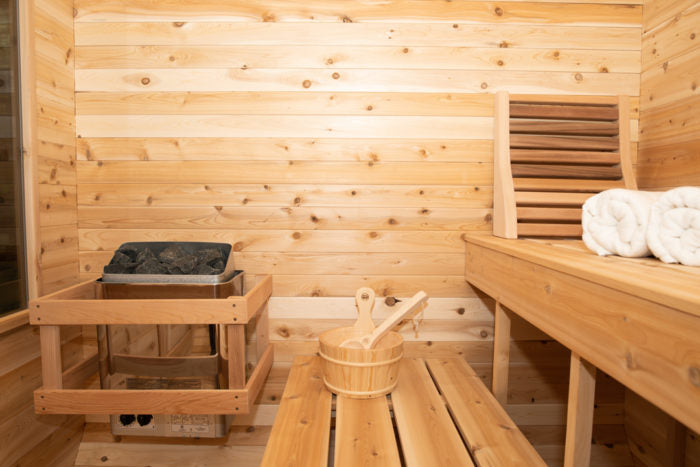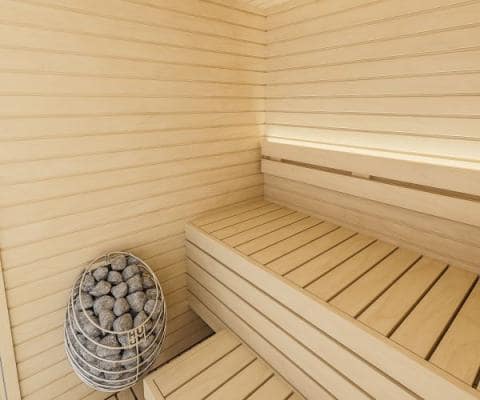Traditional Sauna Can Be Fun For Anyone
Traditional Sauna Can Be Fun For Anyone
Blog Article
Some Of Traditional Sauna
Table of ContentsWhat Does Traditional Sauna Do?Some Known Questions About Traditional Sauna.Traditional Sauna - QuestionsTraditional Sauna for BeginnersThe Traditional Sauna Diaries
A lot of the weight lost in a sauna is water loss and is re-gained upon rehydrating. Nevertheless, certainly sauna can be a vital part of a healthy weight management program. To take a look at the distinctions between typical and IR saunas, I will divide these into proven, academic, and fabricated distinctions.Hence, the hottest point in the saunawhich goes to the ceiling directly above the sauna heateris normally in between 185 and 190 F. Claims that a conventional sauna goes beyond 200 F is simply not real and not relevant for electrical saunas offered in the United States. The temperature for a far-infrared sauna is normally set in between 120 and 140 F; however, unlike the traditional sauna, the goal in and IR room is not to accomplish a heat.
As a result of this, the temperature level distinction is almost unnecessary, considering that excessive sweating leads to both sauna kinds, however the approach of heating up the body is various. In an IR sauna the bather will feel hot and will sweat profusely, but at a lot lower temperature levels (Traditional Sauna). Thus, if the goal is to spend longer amount of times in the sauna, the IR sauna is an excellent option
When a standard sauna has been appropriately heated up, the sauna walls are cozy, the air temperature level has attained established temperature level and the rocks are extremely heated. As an interesting side note, the warmed wall surfaces and the rocks are sending out far-infrared heat, incorporated with the warmed air, to produce an "covering heat".
Traditional Sauna Fundamentals Explained

When the heat is achieved, the components cycle on and off to keep the high temperature. Most typical sauna individuals appreciate pouring water over the rocks to produce heavy steam to raise sauna humidity levels. The advantages of putting water over the rocks include: making the area more comfortable, dampening the nasal flows, and permitting the use of aromatherapy by mixing necessary oils with the water.

When the power enters the body, it triggers the body temperature level to raise and ultimately causes sweat. In an infrared sauna it's crucial for the emitters/heaters to remain on virtually frequently. Since there is no mass of rocks to keep warm, the sauna will cool if the emitters turned off.
As stated above, the sauna bather in an infrared space wants to position himself in front of running emitters to obtain maximum take advantage of the warmth. The heating time for both areas can be extremely different, depending upon just how the areas are made use of. For a typical sauna, a bather ought to permit 30-40 minutes for the room to achieve a desired temperature and to correctly pre-heat the rocks.
Not known Incorrect Statements About Traditional Sauna
A well created sauna will typically achieve a temperature of 150-160 F in about 30-40 mins. For hotter temperatures, the area might need to warmth for a longer duration.

Standard saunas have a tendency to be larger (therefore use even more electricity) than infrared saunas, although conventional saunas are definitely readily available in one and two person sizes. For a two-person typical sauna, 5x6 or 5x7 size is most prominent. The leading bench can easily seat 2 or three people and is also long enough to lie down during the sauna session.
Traditional Sauna Things To Know Before You Buy
The typical price per kWH of electricity in the U.S. is around $0.11, so a 4.5 kW heating system will certainly set you back approximately $.50 to run for one hour, if the heating system runs continually for one hour. Normally a sauna heater will run for 75% of the first hour and 50% of succeeding hours on considering that the aspects cycle once the established temperature is attained.

There is a seldom reviewed distinction in the social experience in between the 2 spaces. While our culture has actually lost some of the social benefit of the conventional sauna experience, it can be really socially satisfying (Traditional Sauna). From family time in the sauna, to heart-felt discussions with loved ones, to sauna partiesthe traditional sauna experience can bring about intimate mingling
The Main Principles Of Traditional Sauna
Most greater end infrared areas include tinted light therapy, audio systems and full-glass fronts.
Report this page